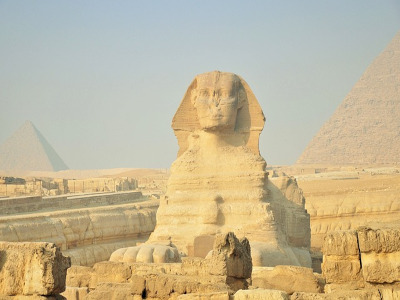The Sphinx of Giza is located about five hundred meters from the pyramids of Cheops and Khafre and its function was to be a guardian of the colossal necropolis. It is undoubtedly the largest and most famous of the ancient sculptures that have survived till our days. The fascination and admiration brings thousands of visitors from all over the world. Its reputation derives from all the legends and various interpretations that were invented during the years.
For many centuries this sculpture remained buried under the desert sand and was only discovered in the second half of the 1800. The deterioration of the monument is partly due to natural erosion, partly caused by the pollution of the Cairo area, but it is also said that the deterioration is also the result of an act “vandalism” of the Napoleonic army that during an exercise aimed with the cannons at the Sphinx head, finishing destroying the nose.
Like I said before the Sphinx is inside the archaeological area of Giza, the Sphinx is part of a large funerary complex dedicated to the pharaoh Khafre. In fact, near the colossal sculpture there are other important buildings:
The first one is the Sphinx temple.
Meanwhile the second one is the temple of the Chefren valley.
The appearance of the Sphinx is the result of a very particular “mix” (if we can say like this) of human and animal forms. The body is that of a lion that is crouching on the floor, with the front paws extended forward, the tail resting on the right thigh and the head is human with the appearance of a pharaoh. The lion body and the human head symbolize the union between the beastly strength and the intelligence of the solar god Harmakhis, protector of the necropolis and with whom the pharaoh is usually associated.
The Sphinx is built inside a depression, surrounded by a sort of limestone basin and depicts the body of a lion and the head of a pharaoh, looking east.
The face of the Sphinx is thought to represent Khafre; in fact the pharaoh would have dedicated the monument to himself, at the same time as the pyramid.
On the head of the Sphinx you can clearly see a “nemes” that is a typical headgear that pharaons used to wear, it symbolizes the power and the richness, in fact all these headgear were done with very expensive materials.
According to most experts, the Sphinx of Giza dates back to 4,500 years ago, therefore it would have been built during the 4th dynasty. From this analysis, experts found out that the oldest facing blocks, from the traces of the workmanship and from the ceramics found on site, it revealed that the Sphinx is contemporary with the construction of the great pyramids present in the same necropolis area.
A very interesting fact about the Sphinx is that while this enormous statue was in restoration, near one of the paws, was found a stone on which was narrated all the life and the most important events of the life of the pharaoh Tutmose and of his reign.

Sources
https://en.wikipedia.org/wiki/Great_Sphinx_of_Giza
